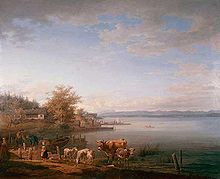Max Josef Wagenbauer
Max Josef Wagenbauer or Max Joseph Wagenbauer (born July 28, 1775 in Öxing ; † May 12, 1829 in Munich ) was a German painter and lithographer .
Life
Wagenbauer attended high school and then studied with Johann Jakob Dorner the Elder and Johann Christian von Mannlich at the Munich Drawing Academy . From 1797 to 1801 he served as a volunteer in a Bavarian Chevaulegers regiment.
From 1801, Wagenbauer received an annual fee for two carefully executed drawings. In 1802 he was appointed court and cabinet draftsman and lived for a time as a drawing teacher in the family of Count Lodron at his castle in Haag in Upper Bavaria .
During the summer he went on study hikes in all parts of Bavaria and devoted himself almost exclusively to landscape painting . He left numerous watercolors , including from Lake Constance (1806), Passau , the Upper Palatinate (1807) and the Wetterstein Mountains . From 1810 he turned more and more to oil painting .
Together with other artists, he received an order from King Max Joseph in 1811 to furnish the dining room in Nymphenburg Palace with large paintings of Bavarian lakes. In 1814 Wagenbauer went on a study trip through Upper Bavaria. He was a member of the art academies in Hanau , Berlin and Munich.
The king, who repeatedly bought paintings by Wagenbauer and gave them away to befriended farms, appointed him inspector of the Royal Picture Gallery in 1815. After 1820, Wagenbauer limited himself to simple motifs and with his precise studies of nature became the forerunner of the Upper Bavarian landscape painting of the Munich school . In close connection with this he also dealt with animal painting .
From the beginning of his artistic activity, Wagenbauer also intensively cultivated lithography . In this technique, too, he left behind numerous depictions of landscapes and animals, as well as a number of templates for drawing lessons, which for a long time served as patterns in southern German drawing schools and had a strong influence on the following generation. A servant who carried the prepared stone slab on his shoulders had to accompany him on his excursions into the near Munich area. Wagenbauer thus saved himself the task of sketching on site. The prints were published in the First Lithographic Art Institute, which was affiliated with the Munich holiday school.
Most of his watercolors are kept in the State Graphic Collection in Munich .
tomb
The grave of Max Wagenbauer is located in the Old Southern Cemetery in Munich (Gräberfeld 6 - Row 16 - Platz 36/37) location .
literature
- Max Josef Wagenbauer . In: Hans Vollmer (Hrsg.): General lexicon of fine artists from antiquity to the present . Founded by Ulrich Thieme and Felix Becker . tape 35 : Libra-Wilhelmson . EA Seemann, Leipzig 1942, p. 22-23 .
- Franz Maria Ferchl: History of the establishment of the first lithographic art institute at the holiday school for artists and technicians in Munich. Munich 1862, p. 122.
- Barbara Heine, Max Joseph Wagenbauer: Upper Bavarian Archive Volume 95, Munich 1972 (with catalog raisonné).
Web links
- Literature by and about Max Josef Wagenbauer in the catalog of the German National Library
Remarks
- ^ Year of birth according to Brockhaus Enzyklopädie, Große Bayerische Biographische Enzyklopädie and Barbara Heine; Thieme / Becker give 1774 as the year of birth.
- ↑ Barbara Heine, p. 8.
| personal data | |
|---|---|
| SURNAME | Wagenbauer, Max Josef |
| ALTERNATIVE NAMES | Wagenbauer, Max Joseph |
| BRIEF DESCRIPTION | German painter and lithographer |
| DATE OF BIRTH | July 28, 1775 |
| PLACE OF BIRTH | Öxing |
| DATE OF DEATH | May 12, 1829 |
| Place of death | Munich |


